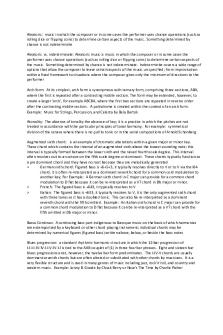Music Theory Notes PDF

| Title | Music Theory Notes |
|---|---|
| Author | Chaidie Petris |
| Course | Introduction To Music Theory |
| Institution | Stanford University |
| Pages | 27 |
| File Size | 2.1 MB |
| File Type | |
| Total Downloads | 7 |
| Total Views | 155 |
Summary
Music Theory Notes...
Description
WORKBOOK – MODULE 6
Name
Exercise 6.1 Beginning with C major, draw the 15 major scales in both clefs using tetrachords. Indicate tetrachords with a bracket. Note: • • •
• • • •
A major scale consists of two tetrachords. Each tetrachord pattern consists of: whole step, whole step, half step. The second tetrachord of a scale begins a diatonic whole step above the last note of the first tetrachord. As shown below, the second tetrachord of C major becomes the first tetrachord of the following scale, G major. The same principle applies to each subsequent scale.
The three pairs of enharmonic scales are C!–Db, F!–G♭ and B–C♭. There are at most seven different sharps or seven different flats in a major scale. The number of sharps increases from one sharp in G major up to seven sharps in C! major. The number of flats decreases from seven flats in C♭ major to one flat in F major.
1. C major
2. G major (1 sharp)
3. D major (2 sharps)
4. A major (3 sharps)
181
W O R K B O O K :
M O D U L E
6
5. E major (4 sharps)
6. B major (5 sharps)
7. F! major (6 sharps)
8. C! major (7 sharps)
9. C♭ major (7 flats)
10. G♭ major (6 flats)
11. D♭ major (5 flats)
12. A♭ major (4 flats)
13. E♭ major (3 flats)
14. B♭ major (2 flats)
15. F major (1 flat)
182
Perfect fifth C G - jaws minor 2nd two adjacent semitones - jaws Major 2nd adjacent 2x semitones - happybday...
Similar Free PDFs

Music Theory Notes
- 27 Pages

Lecture Notes 19C - Music theory
- 16 Pages

MUSIC THEORY FOR DUMNNIES
- 364 Pages

Music Theory Terms
- 29 Pages

Music notes
- 24 Pages

397375933 Music Theory Terms pdf
- 12 Pages

Assign 6 key Music Theory
- 2 Pages

Ancient Greek Music Theory Paper
- 6 Pages
Popular Institutions
- Tinajero National High School - Annex
- Politeknik Caltex Riau
- Yokohama City University
- SGT University
- University of Al-Qadisiyah
- Divine Word College of Vigan
- Techniek College Rotterdam
- Universidade de Santiago
- Universiti Teknologi MARA Cawangan Johor Kampus Pasir Gudang
- Poltekkes Kemenkes Yogyakarta
- Baguio City National High School
- Colegio san marcos
- preparatoria uno
- Centro de Bachillerato Tecnológico Industrial y de Servicios No. 107
- Dalian Maritime University
- Quang Trung Secondary School
- Colegio Tecnológico en Informática
- Corporación Regional de Educación Superior
- Grupo CEDVA
- Dar Al Uloom University
- Centro de Estudios Preuniversitarios de la Universidad Nacional de Ingeniería
- 上智大学
- Aakash International School, Nuna Majara
- San Felipe Neri Catholic School
- Kang Chiao International School - New Taipei City
- Misamis Occidental National High School
- Institución Educativa Escuela Normal Juan Ladrilleros
- Kolehiyo ng Pantukan
- Batanes State College
- Instituto Continental
- Sekolah Menengah Kejuruan Kesehatan Kaltara (Tarakan)
- Colegio de La Inmaculada Concepcion - Cebu







